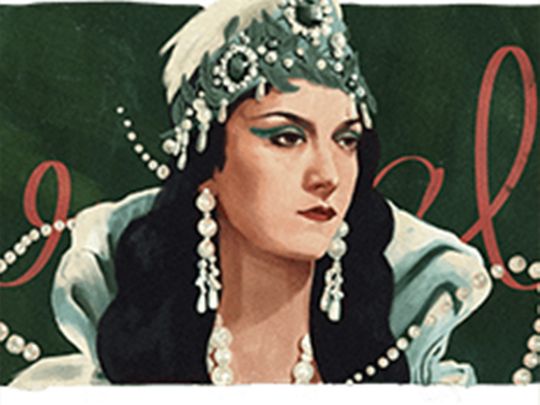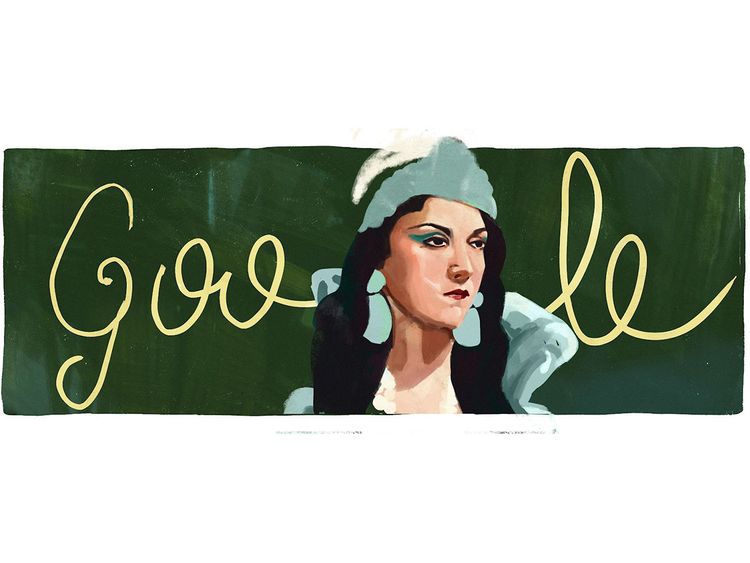
Abu Dhabi: Google Doodles are the fun, surprising, and sometimes spontaneous changes that are made to the Google logo to celebrate holidays, anniversaries, and the lives of famous artists, pioneers, and scientists. Google teams have created over 4,000 Doodles for the homepages around the world.
Google today celebrates Bahiga Hafez’s accomplishments on the 112th anniversary of her birthday, through Google Doodle, but who was she?
Despite the fact that at the beginning of the twentieth century women were still relegated to an inferior position in Egypt, Egyptian cinema was founded in the 1920s by pioneering women who were kindled by a strong desire to develop a local film industry.
Among those women was the Alexandrian Bahiga Hafez, a talented woman who ventured into cinema, despite overwhelming odds, to not only act but also direct, produce, edit, design the costumes and compose the sound track of her movies, hence emerging as one of the pioneers of Egyptian cinema industry.
Hafez was born on August 4, 1908 to a respectable and well-established Alexandrian aristocratic family. She benefited from that immensely privileged background: she came to master, apart from Arabic, English, French and Italian, thanks to the education she received in language schools and the cosmopolitan spirit of Alexandria at that time.
Promising young artists
Hafez was taught music at a very early age and learned to appreciate the arts as she was brought up in an artistic milieu created by her father who was a patron of the arts and encouraged promising young artists, among whom were Abdel Hai Helmi and Abdou el Hamouli, at his house in Moharrem Bey.
She got married at a young age, as was customary at that time, to an Iranian prince. This premature marriage, however, lasted for a short while after which she left for Paris to study music academically. She was able to obtain a degree in music in 1930 and after her return to Egypt and her father’s death, she became a professional teacher of music.
Fate, however, had something in store for her, for on meeting Mohamed Karim, the actor-turned-director, her life turned about dramatically. Impressed by her beauty and intelligence, Karim chose her for the leading role in his silent movie Zeinab, a cinematic adaptation of Mohamed Hussein Heikal’s novel by the same title. In his memoirs, the director Mohamed Karim wrote that he chose Hafez because of her Egyptian features and her elegance. He added that she spoke broken Arabic with an Alexandrian dialect.
Conservative aristocratic family
Hafez’ love for the arts encouraged her to accept his offer. Her decision, however, provoked the ire of her conservative aristocratic family, which considered it an affront to their dignity. Her insistence on her decision, which was fired by her powerful spirit, drove her family to disavow her. It is even said that her sister went into mourning and people offered their condolences to her for, in their eyes, Bahiga Hafez was dead.
Her multi-faceted talent surfaced in this film for she not only acted but also composed the sound track of the film which was recorded and played back during the show. It was during the shooting of this film, which lasted for twenty-one months, that she met and married Mahmoud Hamdi.
Karim says in his memoirs that there was a scene in which the heroine was supposed to suffer from tuberculosis while Hafez was notably overweight. Karim refused to continue shooting and ordered her to lose weight and she complied.
The establishment of Studio Misr, the first well-equipped Egyptian studio, in 1935, encouraged her to realise the dream of her life which was to produce and direct the grand-scale historical film Laila, Daughter of the Desert (Laila bint el sahrâ’), but was not released until 1944 with a new title, Layla al-Badawiyya (Layla the Bedouin). Hafez worked as director, producer (with Fanar Films), co-screenwriter, composer, and lead actress. The film was to be premiered at the Venice Film Festival in 1938 but was banned from playing in Egypt due to its negative depictions of Persians, especially Persian royalty; it was to be released the same year in Egypt as the wedding of the Shah of Persia and the Princess Fawzia of Egypt. Unfortunately, the film wasn’t very successful.
After not working in film for quite some time, Hafez was asked by director Salah Abou Seif to star as one of the Princesses in his film el Qâhirah talâtîn (1966). This marked Hafez’s return to cinema, but also her last appearance.
Strong character
Youssef Wahbi, the famous Egyptian actor, director and producer, singled her out to star opposite him in the first Egyptian sound film The Elite (Awlâd el dhawât) that was to be shot in Paris. It seems, however, that she fell out with Youssef Wahbi for she left Paris without completing the movie and sued him on her arrival to Egypt. This case was a precedent in Egyptian courts.
Being the strong character she was, this quarrel did not keep her from pursuing a career in cinema, for on her return to Cairo, she teamed up with her husband and established Fanar Film Company to produce her own movies.
The first film of their production was the silent movie The Victims (el Dahâyâ) by Ibrahim Lama, which was released in 1932. This film stands as proof of her all-round talent as she was the producer, actor, editor, costume designer and composer of the music of the movie. A copy of el Dahâyâ was found in 1995.
Unfortunately, much of her work as a filmmaker has been lost and only the mentions of her work remains.










